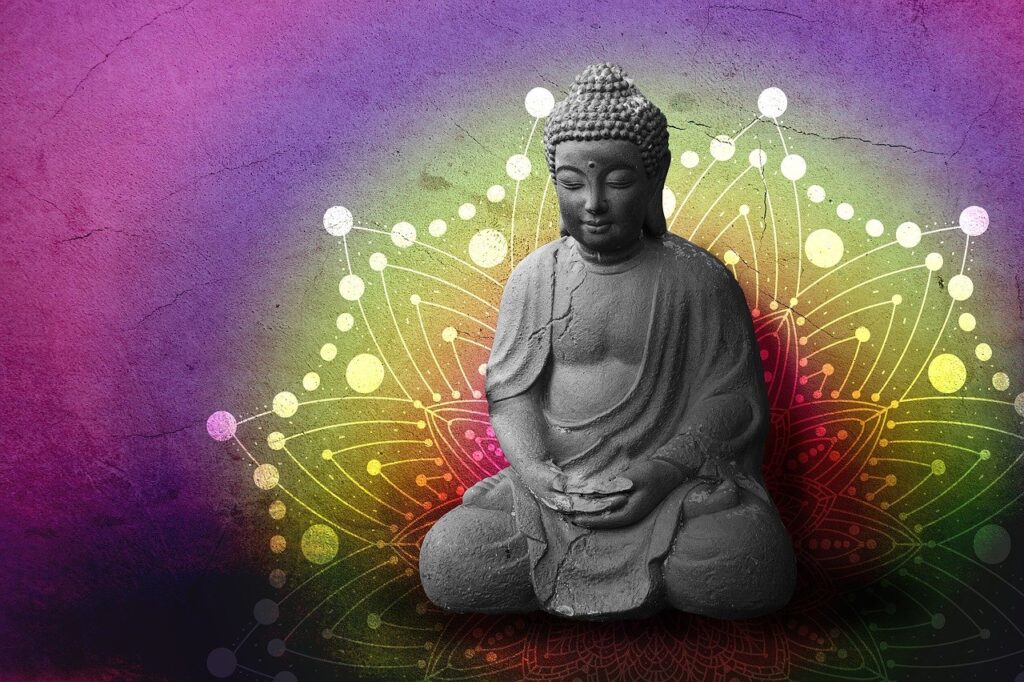Welcome to the complete guide to mastering Reiki symbols. Reiki symbols have a deep meaning in energy healing, acting as portals through which universal life force energy flows. In this comprehensive guide, I will teach you how to unlock the mystery and power hidden in this sacred symbol.
Follow us on a journey that reveals the essence, meaning, and transformational power of the Reiki symbol in the practice of spiritual well-being and healing.
Understanding Reiki Symbols:
Reiki symbols are sacred and powerful tools used in Reiki, the ancient Japanese healing art. These symbols are considered essential elements of Reiki practice and are often passed down from Reiki masters to their students during transformation or training. Each symbol contains a specific vibrational frequency and is a focal point for the flow of energy in Reiki healing sessions.
The origin of Reiki symbols:
The origin of Reiki symbols can be traced back to the founder of Reiki, Doctor, and begins with Mikao Usui who is said to have rediscovered this healing system in the late 19th or early 20th century Usui is believed to have received these symbols as a deep spiritual experience or knowledge gained on Mount Kurama in Japan. The symbols, with their mantras or names, were central to Usui teachings and became an integral part of Reiki practice.
The sacred significance of Reiki practice:
In Reiki practice, symbols are revered for their sacredness and functionality. Each sign carries its unique energy symbols, representing different aspects of healing, protection, and spiritual growth. The symbols serve as keys that help practitioners enter higher states of consciousness and channel universal life force energy, also known as “Qi” or “Chi,” towards healing.
The Symbols and Their Meanings:
Cho Ku Rei, Hon Sha Ze Sho Nen, Sei He Ki, and Dai Ko Myo are a few of the main symbols of Reiki. Every sign has its meaning and characteristics:
- Cho Ku Rei: The Power Symbol is a tool for focusing and increasing energy.
- Sei He Ki: The Emotional/Mental Symbol, designed to resolve emotional problems.
- Hon Sha Ze Sho Nen: A symbol of connection that can be used to connect people over time and place and for distance healing.
- Dai Ko Myo: The Master Symbol, associated with spiritual awakening and enlightenment.
Using Reiki Symbols:
During Reiki sessions, practitioners may draw or visualize these symbols with the intention of invoking their energy and purpose. They can be used in the hand position, drawn on the recipient’s body, or visualized for healing at a distance. These symbols act as amplifiers, intensifying the flow and effectiveness of Reiki energy.
Sacredness and Respect:
In Reiki practice, symbols are viewed with great reverence and respect. They are often transmitted through attunements from a Reiki master to another student and kept private. The idea that they contain divine energy makes them sacred, and using them properly calls for moral behavior, sincerity, and a sincere desire to cure.
Exploring Key Reiki Symbols
-
Cho Ku Rei (Power Symbol):
- Meaning: Represents power, protection, and intensifying energy.
- Purpose: Used to enhance the power of Reiki and focus energy.
- Applications: Applied at the beginning of sessions to amplify energy flow, on specific body areas needing extra energy, and to clear spaces or objects.
-
Sei He Ki (Mental/Emotional Symbol):
- Meaning: Symbolizes harmony, purification, and healing of emotions and the mind.
- Purpose: Aids in healing emotional and mental issues.
- Applications: Applied to areas where emotional blockages are present, or where healing of past traumas is required.
-
Hon Sha Ze Sho Nen (Connection Symbol):
- Meaning: Represents unity, connection, and beyond time and space.
- Purpose: Facilitates distant healing and connects past, present, and future.
- Applications: Used for distance healing across geographical distances and for healing relationships, past events, or future situations.
-
Dai Ko Myo (Master Symbol):
- Meaning: Signifies enlightenment, spiritual transformation, and divine energy.
- Purpose: Associated with higher spiritual consciousness and empowerment.
- Applications: Used in spiritual healing, to deepen meditation, and for spiritual awakening and guidance.
Each symbol has its unique energy and purpose, allowing Reiki practitioners to focus on specific aspects of healing. By understanding and utilizing these symbols, practitioners can enhance the effectiveness of Reiki sessions, address various issues, and access higher levels of healing energy and consciousness.
Understanding the Power of Reiki Symbols:
Reiki symbols play an important role in facilitating healing and balance by serving as focal points for channeling and directing healing energy. They help practitioners access, focus, and amplify universal life force energy (Reiki) during healing. Here’s how to facilitate healing and balance, with insights on how to adapt and work with these symbols:
Facilitating Healing and Balance:
- Energy amplification: Reiki symbols act as amplifiers, intensifying the flow and continuity of Reiki energy. They help practitioners maximize the strength and effectiveness of therapeutic energy directed at the patient.
- Targeted Healing: Each symbol carries its own vibrational frequency and unique purpose. When used intentionally, it allows practitioners to address specific issues such as physical ailments, emotional imbalances, or spiritual obstacles.
- Harmonize energy: By invoking Reiki symbols, practitioners aim to harmonize the client’s energy field. This practice helps release energy blockages, balances the chakras, and restores the flow of energetic energy throughout the body.
Attuning to and Working with Reiki Symbols:
- Obtaining attunements: To work with Reiki symbols, practitioners have attunements from Reiki masters. During the attunement ceremony, the symbols are transferred to the practitioner’s energy field, allowing them to interact with and manipulate the energies of the symbols
- Memorization and Visualization: Practitioners memorize the names of the symbols, along with corresponding shapes and mantras. Symbols are often visualized or drawn in the air, on the hands, or in the mind during healing to activate and harness their energies.
- Mindfulness and Concentration: Working with Reiki symbols requires a clear and focused mind. Practitioners establish healing intentions, visualize or draw the symbols, and direct Reiki energy to the client, allowing the symbols to guide and amplify the healing process
- Practice and Experience: The skill of working with the Reiki symbols is through practice and experience. As practitioners continue to use the symbols in healing sessions, they increase their connection to, understanding of, and use of the unique characteristics of each symptom.
By tuning in to these symbols and using them in healing sessions, practitioners can harness their transforming energies to help recipients recover, restore balance, and promote overall well-being. The technique requires commitment, practice, and a genuine desire to promote healing and spiritual growth.
Mastering the Use of Reiki Symbols:
Practicing and Integrating Reiki Symbols:
- Regular Practice: Consistent practice is key to mastering Reiki symbols. Devote time to meditate on, visualize, and draw the symbols regularly to deepen your connection with their energies.
- Symbol Meditation: Meditate on each symbol individually. Focus on its form, intention, and the energy it represents. Feel the symbol’s vibration and allow its energy to flow through you.
- Symbol Placement: Understand the appropriate use and placement of each symbol. Learn which symbols are suitable for different healing scenarios, whether for physical, emotional, mental, or distant healing.
- Self-Treatment: Use the symbols in your own Reiki practices. Treat yourself regularly to see direct results and be confident in its effectiveness.
Tips for Utilizing and Focusing Symbolic Energy:
- Clear Intent: Set a clear intention before using Reiki symbols. Define the purpose of using the symbol in a particular healing session to channel energy effectively.
- Visualization Techniques: Visualize the symbols in your mind’s eye or draw them in the air or on your hands with the intention of activating their energy.
- Mantra Chanting: Repeat the name or mantra associated with each symbol silently or aloud during the healing session to enhance its potency.
- Focused Attention: Focus your attention and intention on the symbol while directing Reiki energy. This concentration helps in channeling and directing the energy where it’s needed.
- Trust and Intuition: Trust your intuition when using symbols. Let your intuition guide you in selecting the appropriate symbols and their application in different healing scenarios.
- Feedback and Reflection: Seek feedback from recipients or clients after using symbols in healing sessions. Reflect on your experiences to refine your understanding and application of the symbols.
- Ethical Use: Use Reiki symbols ethically and with pure intent. Respect the confidentiality and sacredness of the symbols and their teachings.
Practicing with Reiki Symbols:
Techniques for Working with Reiki Symbols:
-
Symbol Visualization and Activation:
- Find a quiet and comfortable space for your Reiki practice.
- Begin with relaxation techniques or deep breathing to center yourself.
- Visualize the symbol you intend to work with. Picture its form clearly in your mind.
- Draw or trace the symbol in the air in front of you, imagining it glowing with vibrant energy.
- Invoke the symbol by mentally or verbally stating its name or mantra thrice to activate its energy.
-
Symbol Placement and Healing Session:
- Prepare for a Reiki healing session with a client or for self-treatment.
- Set your intention for the session and the specific purpose of using the chosen symbol.
- Draw the symbol in the air or visualize it, intending to place it over the recipient’s body or your own energy centers (chakras).
- Direct Reiki energy through your hands, focusing on the symbol and allowing its energy to flow.
Step-by-Step Instructions for Incorporating Symbols into Reiki Sessions:
-
Preparation:
- Sit or stand comfortably in a quiet space, palms facing upwards.
- Take a few deep breaths to relax and center yourself.
-
Cho Ku Rei (Power Symbol):
- Begin by activating the Cho Ku Rei symbol.
- Visualize or draw the symbol on your palms or in the air.
- State the symbol’s name or mantra, “Cho Ku Rei,” three times.
- Focus on amplifying and directing Reiki energy for healing.
-
Sei He Ki (Mental/Emotional Symbol):
- Move on to activate the Sei He Ki symbol.
- Visualize or draw the symbol in front of your heart or the recipient’s heart.
- Repeat the symbol’s name or mantra, “Sei He Ki,” three times.
- Intend to heal emotional or mental aspects during the session.
-
Hon Sha Ze Sho Nen (Connection Symbol):
- Activate the Hon Sha Ze Sho Nen symbol for distant healing or connecting with past or future events.
- Visualize or draw the symbol in the air, intending its application.
- Recite the symbol’s name or mantra, “Hon Sha Ze Sho Nen,” three times.
- Direct Reiki energy for distance healing or establishing connections.
-
Dai Ko Myo (Master Symbol):
- Utilize the Dai Ko Myo symbol for spiritual healing or empowerment.
- Visualize or draw the symbol, focusing on spiritual awakening.
- State the symbol’s name or mantra, “Dai Ko Myo,” three times.
- Channel Reiki energy for spiritual transformation and enlightenment.
Advanced Applications and Ethics:
Advanced Uses of Reiki Symbols in Healing:
- Spiritual Healing and Enlightenment: Advanced people can use Reiki symbols to facilitate deep spiritual healing, aimed at achieving spiritual awakening, inner transformation and enlightenment.
- Chakra Balancing and Activation: Symbols can be placed on specific chakras, clear blockages, and balanced energy centers in the body, increasing overall vitality and well-being.
- Karmic Healing: Practitioners explore using symbols to address karmic imbalances or past-life issues, aiming to release unresolved patterns and promote healing across lifetimes.
- Manifestation and Intention Setting: Advanced Reiki users may employ symbols to enhance the manifestation of intentions, directing Reiki energy to manifest positive changes in life circumstances.
Ethical Considerations and Responsibilities:
- Confidentiality and Respect: Reiki practitioners should respect the privacy of Reiki symbols and teachings, not disclose them without permission or handle them carelessly.
- Pure Intent and Honesty: It’s critical to use symbols with honesty and pure intentions. Practitioners should put healing and well-being first, refraining from using symbols for selfish or immoral purposes.
- Informed Consent: Before beginning a Reiki session, practitioners should get clients’ consent by clarifying the treatment’s principles, including how symbols are used and how they help with healing.
- Respecting Beliefs and Boundaries: Avoid forcing your own beliefs or meanings of symbols on clients during sessions. Instead, respect their boundaries and beliefs.
- Constant Self-Development: In order to expand their understanding, practitioners need to constantly reflect on themselves and look for ways to progress.
- Teaching with Responsibility: Reiki masters sharing symbols should do so responsibly, attuning and teaching only to sincere and dedicated students ready to respect the symbols’ sacredness.
- Non-Interference and Empowerment: Practitioners should honour the principle of non-interference, empowering clients to take responsibility for their healing journey without dependency on symbols or practitioners.
Adopting the general use of Reiki symbols requires a deep sense of responsibility, integrity and faith. Following ethical standards ensures the purity and effectiveness of Reiki treatment, instilling trust and respect in both the practice and the community.
FAQs about Reiki Symbols:
-
What are Reiki symbols, and what is their significance?
Reiki symbols are sacred and powerful tools used in Reiki healing practices. They act as focal points for channeling and directing healing energy. Each symbol holds specific vibrations, aiding in healing and spiritual growth.
-
What are the five symbols of Reiki?
The five symbols traditionally taught in certain Reiki lineages are:
- Cho Ku Rei: Known as the Power Symbol, used to enhance the power of Reiki and draw energy towards specific areas.
- Sei He Ki: Also called the Emotional/Mental Symbol, aimed at healing emotional and mental issues, promoting harmony and balance.
- Hon Sha Ze Sho Nen: The Connection Symbol, facilitates distant healing, allowing practitioners to send Reiki across time and space.
- Dai Ko Myo: Known as the Master Symbol, represents enlightenment, spiritual healing, and the connection to one’s higher self.
- Raku: Some lineages include this symbol representing completion, grounding, and sealing the healing energies at the end of a session.
-
What is the master symbol of Reiki?
The master symbol in Reiki is “Dai Ko Myo.”
It represents enlightenment, spiritual healing, and the connection to one’s higher self. Used in advanced Reiki practices, Dai Ko Myo enhances healing energies and promotes spiritual growth and inner harmony.
-
What are the 7 main chakras worked on during a Reiki session?
- Root Chakra (Muladhara): Located at the base of the spine, it governs stability, security, and grounding.
- Sacral Chakra (Svadhisthana): Positioned in the lower abdomen, it influences creativity, emotions, and relationships.
- Solar Plexus Chakra (Manipura): Found in the upper abdomen, it regulates confidence, personal power, and self-worth.
- Heart Chakra (Anahata): Located in the center of the chest, it governs love, compassion, and emotional balance.
- Throat Chakra (Vishuddha): Situated in the throat, it relates to communication, self-expression, and authenticity.
- Third Eye Chakra (Ajna): Positioned between the eyebrows, it influences intuition, perception, and spiritual insight.
- Crown Chakra (Sahasrara): Located at the top of the head, it connects with spirituality, higher consciousness, and divine awareness.
-
What are the three levels of Reiki?
The three levels of Reiki are typically:
- Level 1 – Shoden or First Degree: Introduces the basics of Reiki, focusing on self-healing and learning hand positions for treating others.
- Level 2 – Okuden or Second Degree: Expands Reiki knowledge, introduces symbols, and enables practitioners to perform distant healing.
- Level 3 – Shinpiden or Master/Teacher Level: Offers advanced training, teaches additional symbols, and empowers individuals to become Reiki Masters, capable of attuning others to Reiki energy.
-
which reiki symbol activates available energy?
“Cho Ku Rei,”
This symbol is often used to increase and enhance the flow of Reiki energy. It’s utilized to focus and amplify energy, making it more accessible and potent for healing purposes. Practitioners often visualize or draw this symbol to intensify the energy flow during Reiki sessions, thereby increasing its effectiveness in healing and balancing energies.
-
where do reiki symbols come from?
Reiki symbols originated from Mikao Usui’s spiritual journey on Mount Kurama, Japan, where he received them during a profound meditation experience.
These symbols were passed down through oral tradition and teachings within specific Reiki lineages. Over time, as Reiki spread globally, some symbols became more accessible to practitioners, while others remained reserved within certain lineages, creating variations in the symbols used across different Reiki traditions and schools.
-
What religion does Reiki come from?
Reiki doesn’t originate from a specific religion. It’s a healing practice developed by Mikao Usui in Japan in the early 20th century, drawing on spiritual and energy healing principles.
-
What is the science behind Reiki?
The scientific understanding of Reiki is not yet fully established. Reiki is often viewed through alternative medicine, which includes the use of healing energy. Studies examine the potential effects on relaxation, stress reduction, and overall well-being, but conclusive scientific evidence supporting Reiki techniques is scarce.
-
Where can I learn about Reiki symbols and their meanings?
Reiki training from a certified Reiki master is the best way to learn about symbols, their meanings, and ethical usage.
Conclusion:
Reiki symbols are very significant in energy healing because they are channels for the life force energies of the universe. This holy symbol supports intents for healing, promotes harmony, and deals with certain aspects of healing—spiritual, emotional, and physical. Their transformative power lies in their ability to deepen healing actions and enhance the flow of healing energy.
Promoting increased study and application of Reiki symbols enables people to delve deeper into their transforming potential, strengthening their bond with healing energies and advancing the development of their general well-being. By analyzing these symbols, practitioners can uncover previously undiscovered dimensions of medicinal journeys and fully utilize their enormous therapeutic potential.




